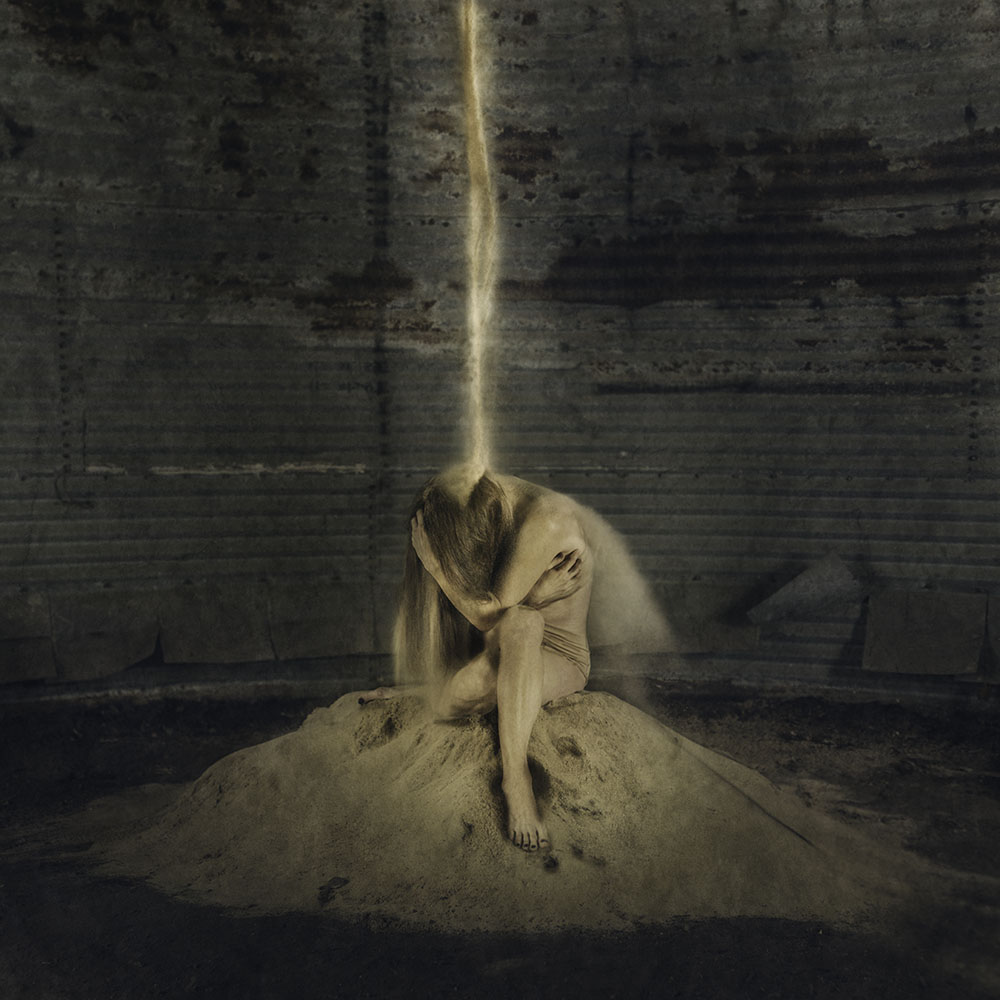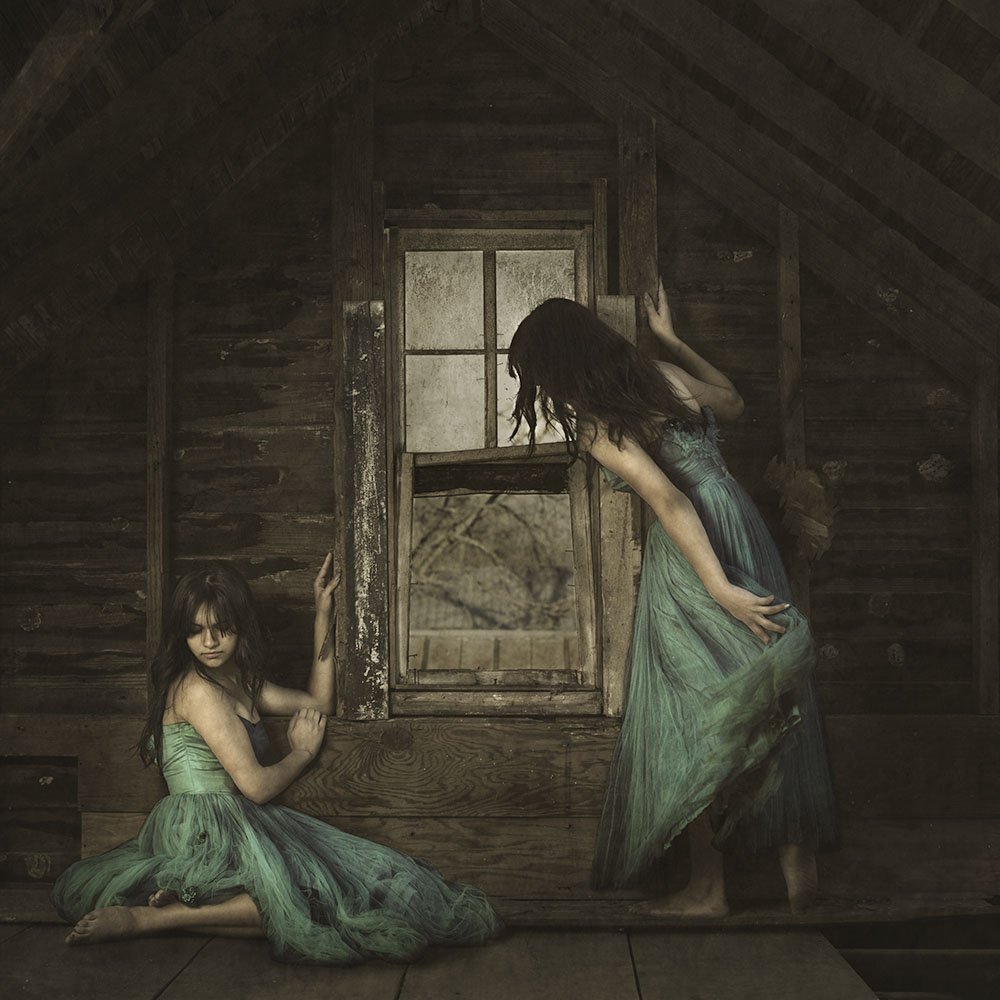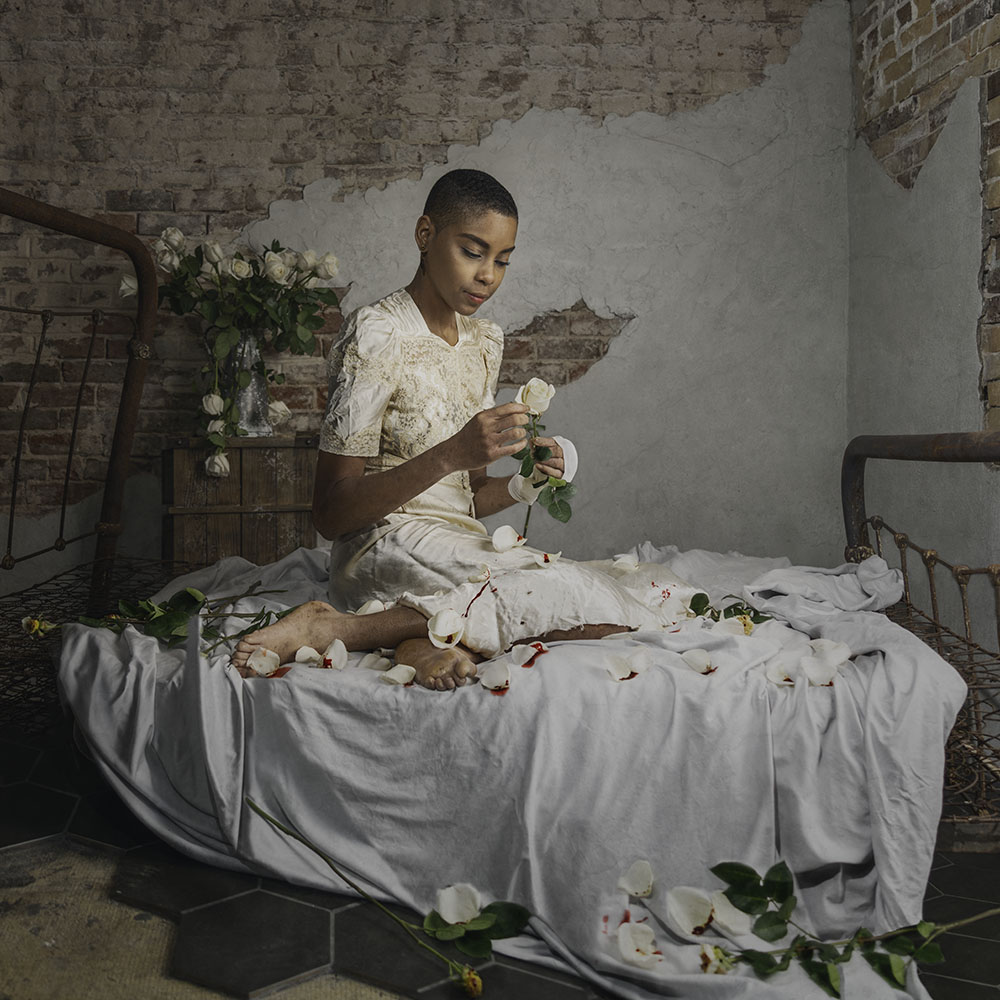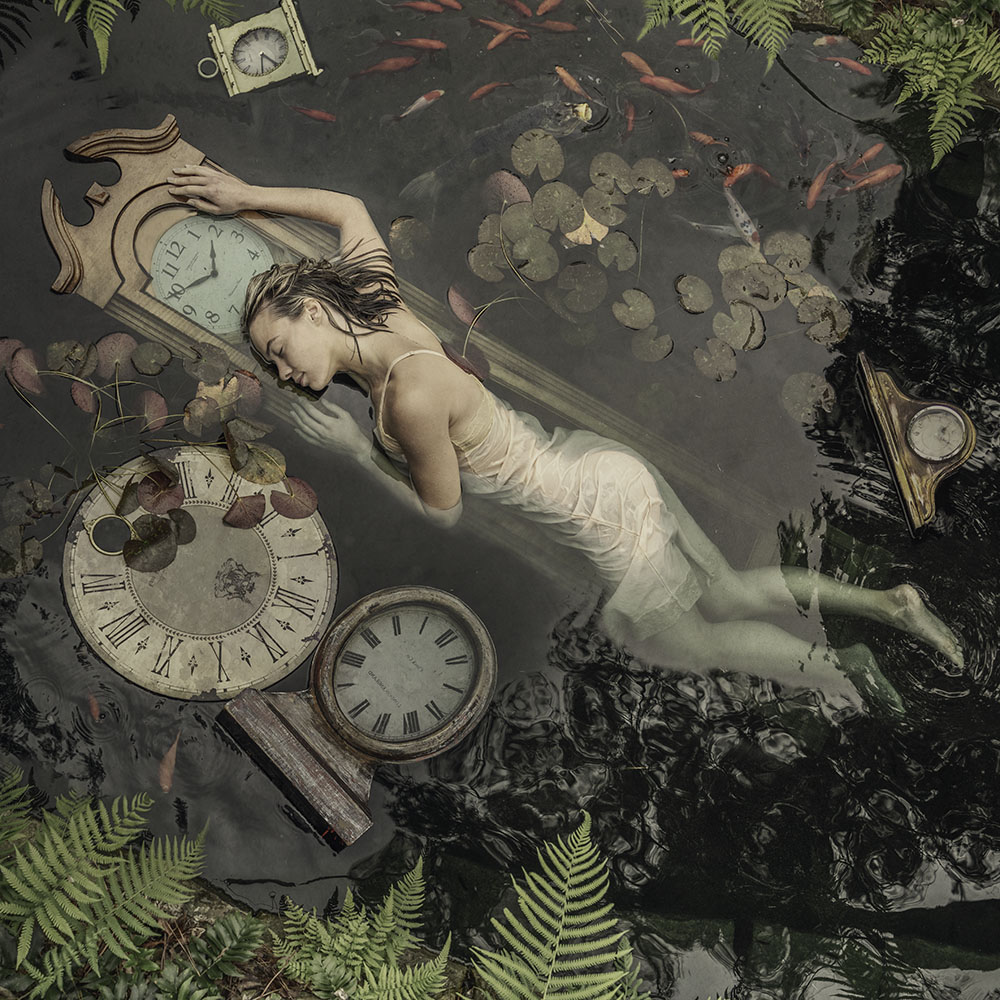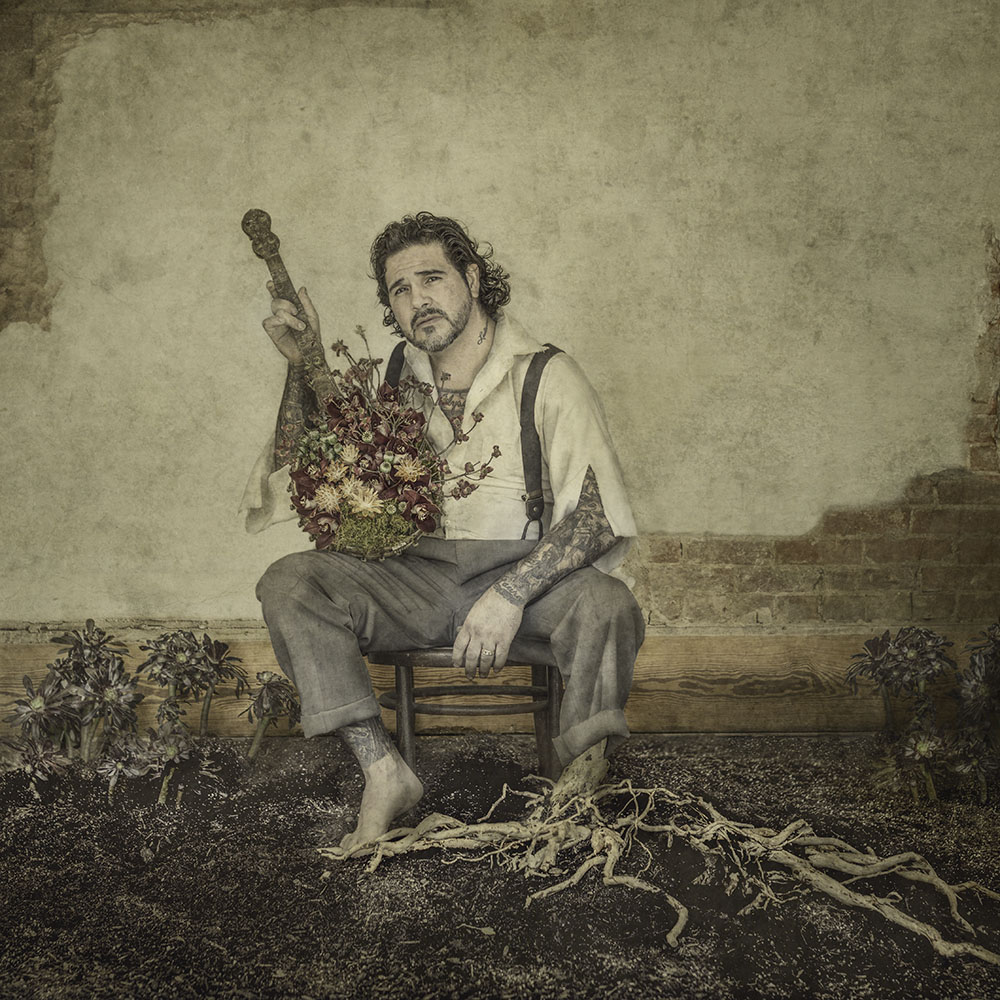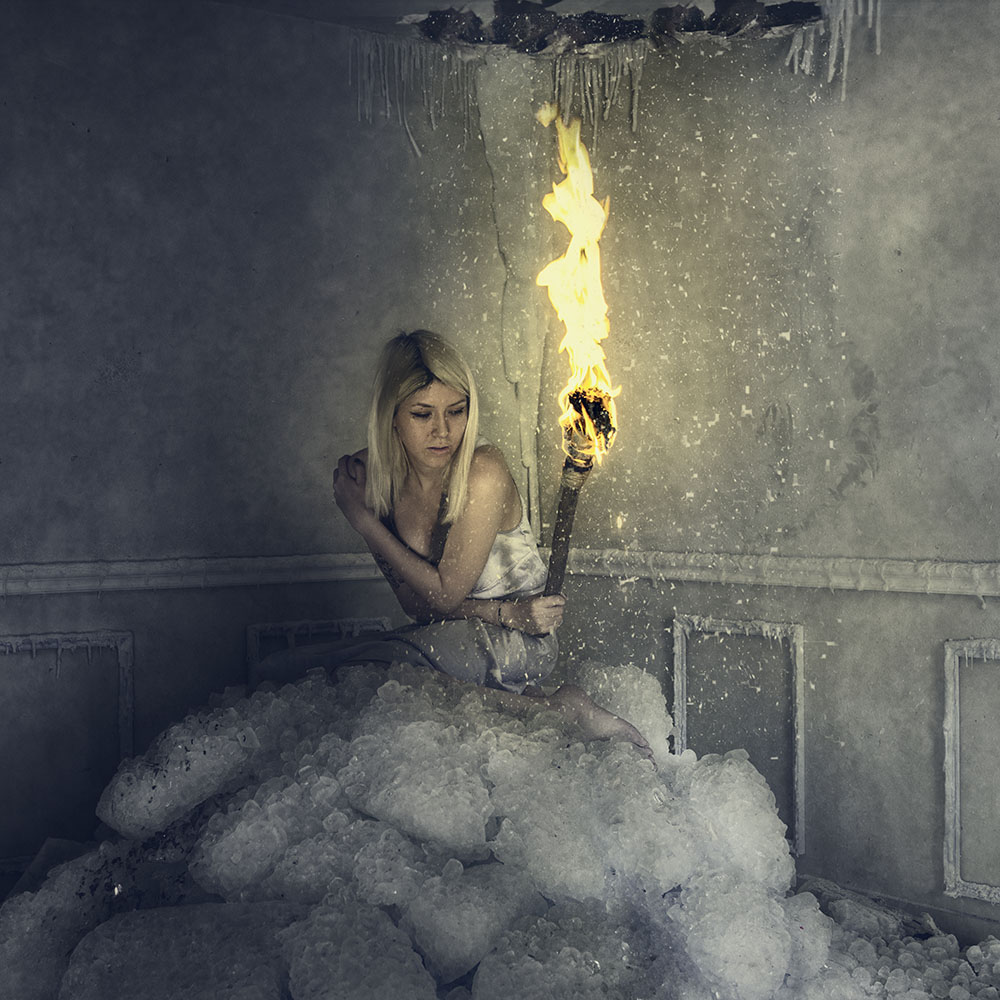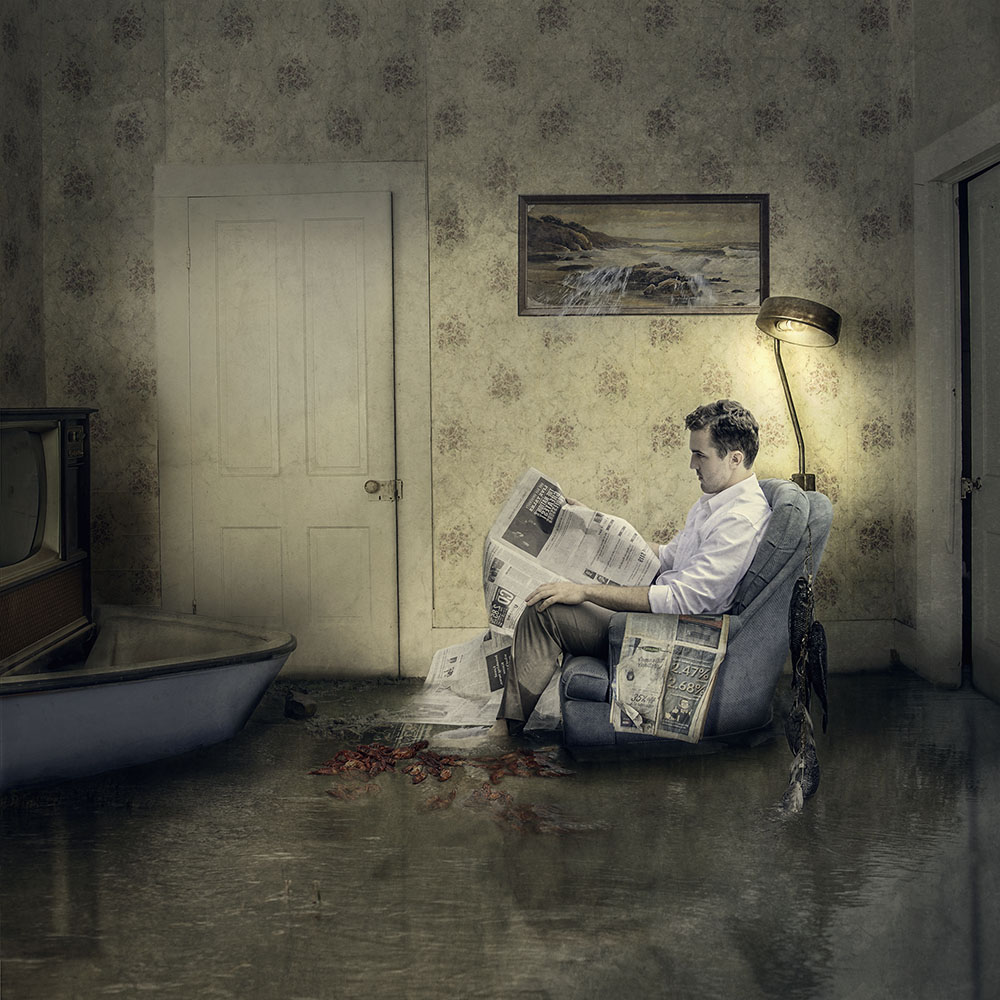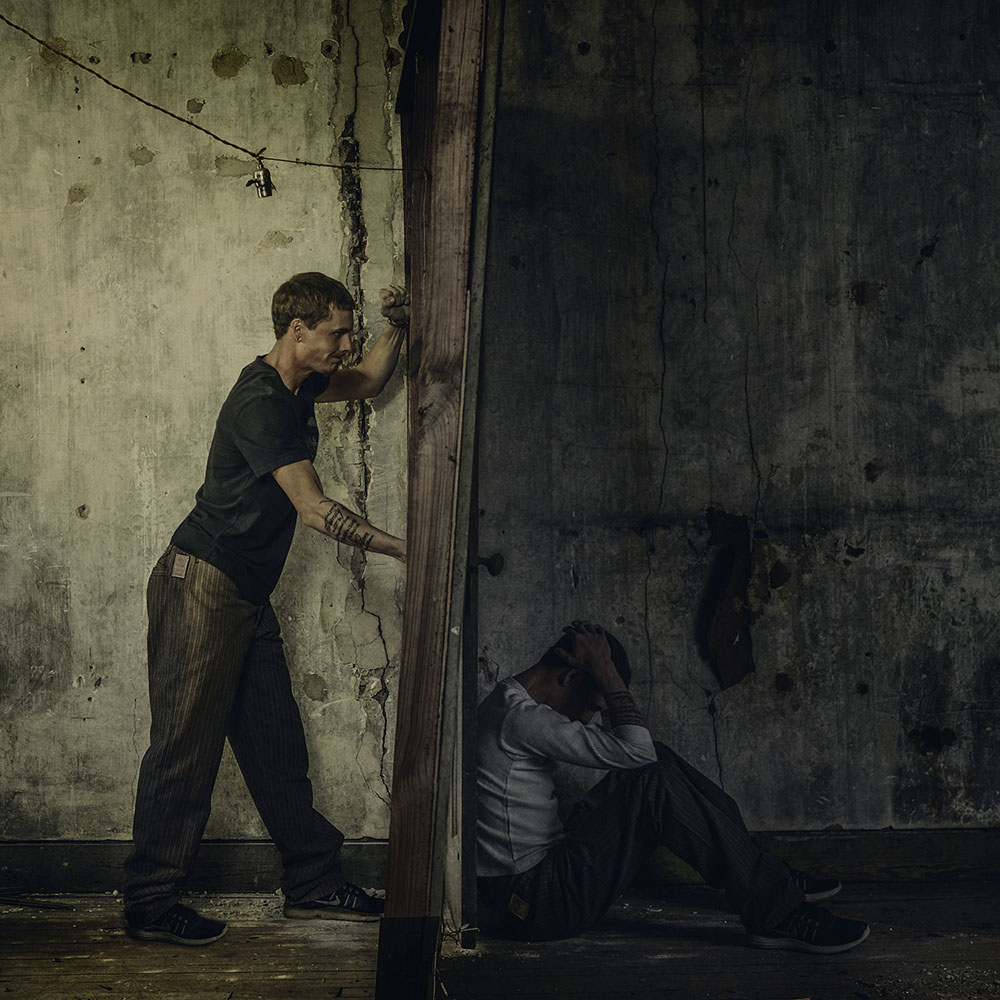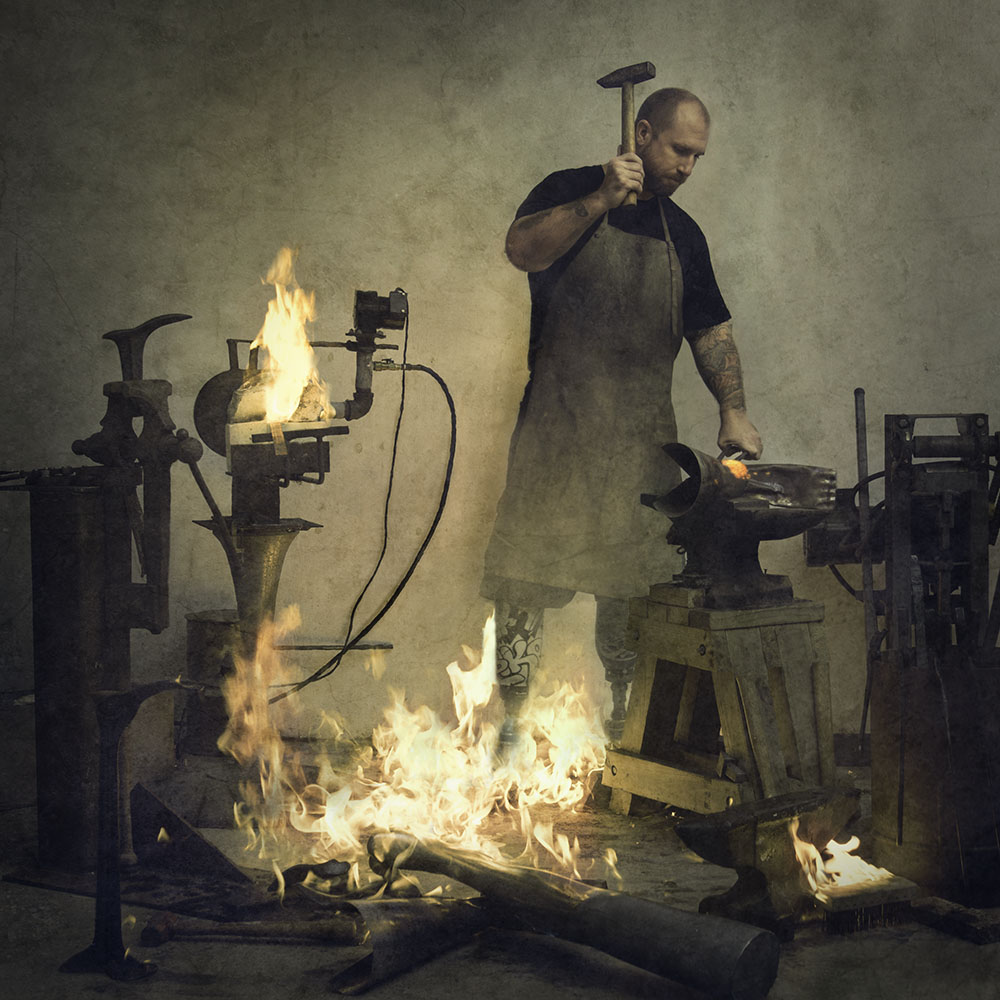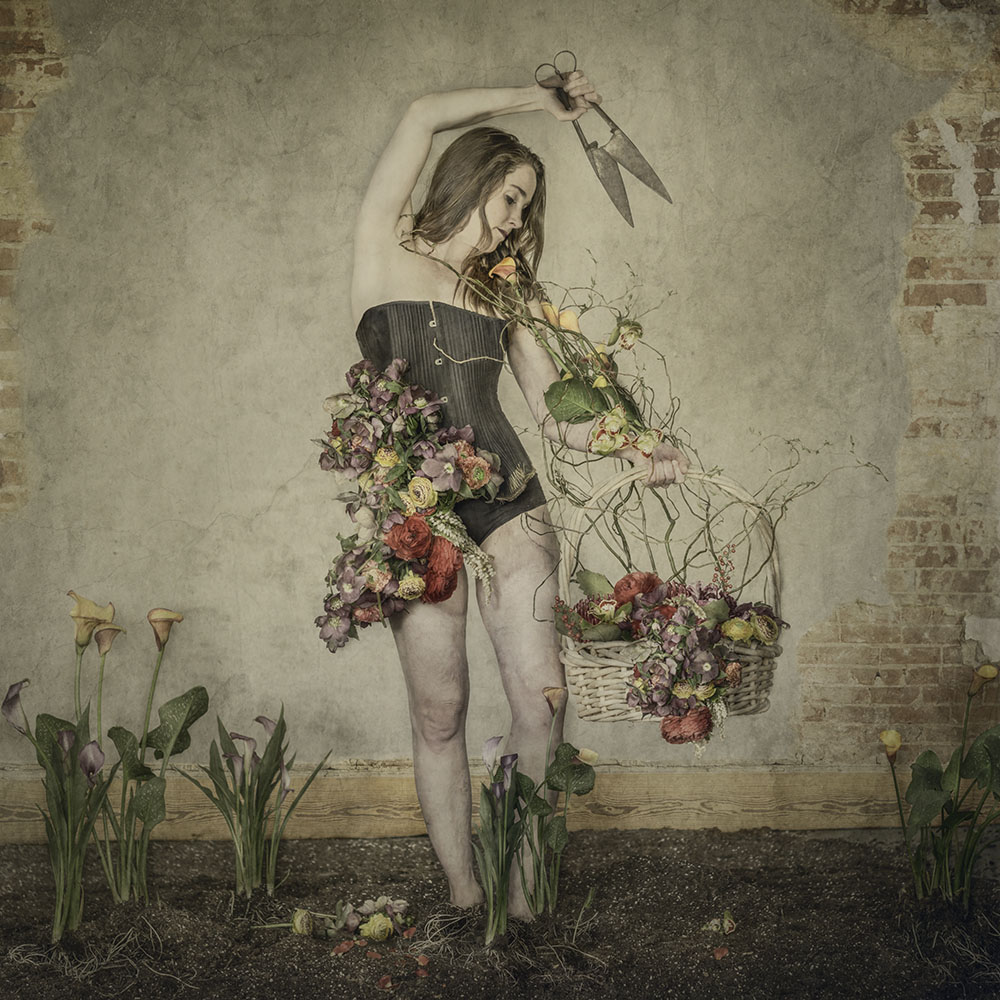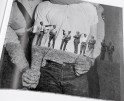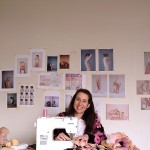Two Keys: Unspoken Stories
Karen and Steve Jackson (aka Two Keys) are photographers living in Bastrop, Texas.
We all have seen people with obvious outer scars: missing limbs, a limp, an eye patch. We may have one, or inner scars that are much harder to divine. Living in this world takes as well as gives. Sometimes it’s hard to tell which action is the gift.
Perusing the possible images for an exhibition a couple of years ago a group of obviously connected photographs caused me to stop, enlarge them and really take a look. Cohesive bodies of work typically stick out in the chaos of the entry process. There was something about this work – it didn’t have the disconnected look that so much composited, photoshopped imagery can have.
They appeared to be hiding something. A foot behind a root, a leg behind a calla lily, a young woman half hidden in a pile of leaves. There was a strange, slight edginess about them. But not edgy – informed by something I could not put my finger on.
I moved on but was drawn back to the image of the young woman half hidden by the pile of leaves. The Spanish word “duende” came to mind – duende, according to Wikipedia, is a Spanish term for a heightened state of emotion, expression and authenticity. The Spanish poet Federico García Lorca described it as, “a power and not a behavior . . . a struggle and not a concept.” Duende works as an adjective when describing art when other descriptors fail for various reasons. I think the closest descriptors we have for this phenomenon in English are ecstatic state or “in the zone.” However, these describe a condition or action, not something alive in the work. Duende in Spanish and Portuguese literally means ghost or spirit.
When I finally got to meet Karen in one of our workshops and she explained their process, I realized we were dealing with ghosts and spirits. Ghosts and spirits of things lost or damaged, but where typically there would be pathos or pity, an empowering form of empathy and celebratory encouragement prevailed.
We believe that everyone has obstacles they must overcome: age, illness, self-esteem, the list is limitless. However, there is an inner strength in all individuals despite these obstacles. We want to take photographs that result in beautiful images of experiences or difficulties showing the strength of an individual, to allow the viewer to look deep within oneself and make a connection with their own strengths. We use real world locations and props to create backdrops into surreal places that produce both negative and positive emotional reactions for viewers. Some images are quiet while others almost create a frenzy for the observer.
The final edited images are nothing like the images taken in camera. Compositing, editing, textures and tonal changes all aid to create surreal painterly portrait forms of art. We hope that viewers will question the “why” and “what” regarding images to create dialogue among others who interpret the images differently. – Karen and Steve Jackson
Could you tell us how ya’ll came to this project, but first tell us a little about yourselves, how you discovered photography, what you have done to put food on the table?
In the mid 80’s Steve took a photography class at a local community college and I (Karen) took a photography class in high school so with really no experience, just enough to be dangerous we decided as a couple, in our 50’s, that we would like to do photography as a hobby to spend time together. We started out doing senior pictures, two weddings, and engagement pictures for friends and quickly realized that we wanted to do something different but didn’t know what that was. While looking at artists on the internet we discovered Brooke Shaden and instantly we were like this is what we want to do. Her work is thought provoking and meaningful. So, we contacted a local photography store to find out about taking Photoshop classes and we were connected to Mark Heaps, a KelbyOne Instructor, and the journey started. A little history: Steve started taking knife making classes back in the early 90’s and at the time the instructor told him to use his job to make a living but use the hobby of knife making for enjoyment and self-expression. So, we adopted that physiology when we started. We don’t charge any of the individuals in the images and they are always gifted a copy of their image. We have sold some images, but the money is either donated to a local restaurant, Comfort Café, which is a pay-what-you-can community cafe for those going through addiction recovery or the Austin Prosthetic Center.
Could you explain your process?
Probably that actual photographing and pushing the button on the camera for most of our photoshoots is like maybe 15 minutes. We go into the photoshoots with a clear picture of what we are wanting to capture. But we probably spend sometimes weeks if not months preparing for a photoshoot. We will drive around looking for the best location for the image and as well as spending time tracking down people that might have various props/clothing we could borrow or making them ourselves. This is a big part of the image process for us because we really like using old, abandoned locations and old vintage props. We feel it kind of helps give the images sort of a timeless feel. Post-processing, that’s funny, in the beginning, not knowing how to use Photoshop, we could spend up to a month trying to create one picture. Now it might take a day or two for a “simple image” and maybe a week for a really complicated composited image. Even today we have images that we still haven’t ever finished because either we decided we need to redo them or that we don’t have the skill sets to create what we imagined in our heads. We do not use professional models. All our images are of people that live in and around our community. We will see someone in the grocery store, at a restaurant, or just through friends and ask them if they would like to be in one of our images. There is something about these individuals that makes me want to approach them and see if they would like to be photographed. I would say 99% of the time, these total strangers, say yes……if you ask them.
Would you mind telling us about some of your personal experiences with your subjects?
Well, most importantly our lives and community are much richer knowing and interacting with these people. We would say that a large number of these individuals have permanent places in our lives. We go out to dinner, talk on the phone, and maintain contact with some almost weekly since the event of photographing them. For some it’s been years. We’ve attended weddings, baby showers, graduations, etc. of many of the people we have been lucky to meet through our photography. We go into these photoshoots hoping that we have made a connection with these individuals and that they will become lifelong friends and not just momentary subjects in an image.
We have an image of a young lady that contracted bacterial meningitis and as a result lost both her legs, parts of her fingers and kidneys. While discussing with her about this time in her life she talked about being in the ICU and having so many machines with cords and tubes that there wasn’t really room for family members to be in the room with her and all she wanted was for someone to be in there and hold at least her hand. In the image we used the gurney to get the viewer into a mindset of a hospital or clinical feeling but then by pushing her back into the vines we wanted this to represent all the wires and tubes around her in a more surreal setting. In the photo you will see arms around her and we were lucky enough that her mom came to the photoshoot and was willing to participate so those are her mom’s arms around her holding her in the image.
We have another image of a young woman that was burned in an accident as a young child, leaving significant scarring on her abdomen and legs. Striving to gain and model strength and inner beauty to be a positive example for her daughters and others she agreed to be a part of a photoshoot. This was her first image with us, and you really can’t see any scars but doing the shoot gave her much insight into her own self. She emailed me after the photoshoot and wrote: “What a metaphor the sand pouring down on me represented. The weight of carrying around this thing that I often keep hidden…the weight of hiding…. trying to lift my head and keep a neutral face despite what might be going on in my head. It’s amazing to me that the process and surreal image turned out to be so representative of part of my reality.”
Do you have personal life experiences that have informed your work?
Some of the images are definitely from some of my, Karen, personal experiences. I was a single mom of three and some of the images reflect having to let them go out into the world as young adults and me being left behind, or waiting for a phone call related to both good and bad outcomes. More importantly we believe that everyone, us included, has had dark events occur in their lives and creating dark themed art allows us and our models to heal and feel empowered about their recovery. We are not unique to loss or tragedy.
What do you see as the future of your project?
First, we are still trying to figure out what our “style” is even after 5 years. We are constantly trying new things just to see what will happen. We think aesthetically we create dark colored images basically because we don’t have a strong background in color theory and so we are creating images that look good to us even if they aren’t based on some sort of art process. We have tried to go lighter in all aspects and for us it’s just natural to go to the dark side so we are OK with people not liking our art, because it’s not warm and fuzzy and might evoke uncomfortable feelings. We have been working on a continuing project of individuals getting into an actual koi pond with the fish to be photographed. (AT
We recently found out about a disorder called Epidermolysis Bullosa (EB) which is a rare genetic condition that makes skin so fragile that it can tear or blister at the slightest touch. Children born with it are often called “Butterfly Children” because their skin seems as fragile as a butterfly wing. We would love to do a project with some of these individuals and bring awareness to this condition in our local area. We would photograph them and then paint butterflies over the different areas that are affected on the canvas of the final image. So the images would have a mixed media process.
Since you didn’t answer this in the first question, just kidding, I know it would interest the readers to know what you and Steve do and did for a living. I think it also informs the “Duende” reference — which I believe is at the core of so much art — the ghost or soul of a thing that can’t be taught and appears to come from the ether, a connection with something thumbing its nose at easy logic and classification.
Steve was a jet pilot in the Marine Corp and after that he became a commercial airline pilot. I was a high school biology teacher then once I finished my masters became a wildland firefighter for the Texas Forest Service.
Kevin Tully is co-director of A Smith Gallery in Johnson City, Texas. Kevin is also an artist and carpenter.
Posts on Lenscratch may not be reproduced without the permission of the Lenscratch staff and the photographer.
Recommended
-
Ricardo Miguel Hernández: When the memory turns to dust and Beyond PainNovember 28th, 2025
-
Pamela Landau Connolly: Columbus DriveNovember 26th, 2025
-
KELIY ANDERSON-STALEY: Wilderness No longer at the Edge of ThingsNovember 19th, 2025
-
Jackie Mulder: Thought TrailsNovember 18th, 2025
-
Accidental Evidence: Mike Mandel and Chantal ZakariOctober 22nd, 2025


